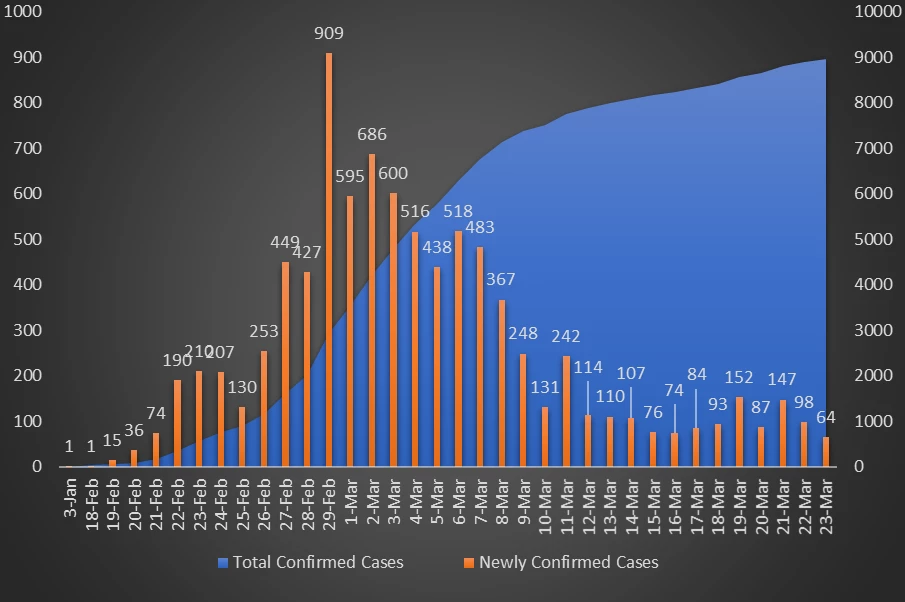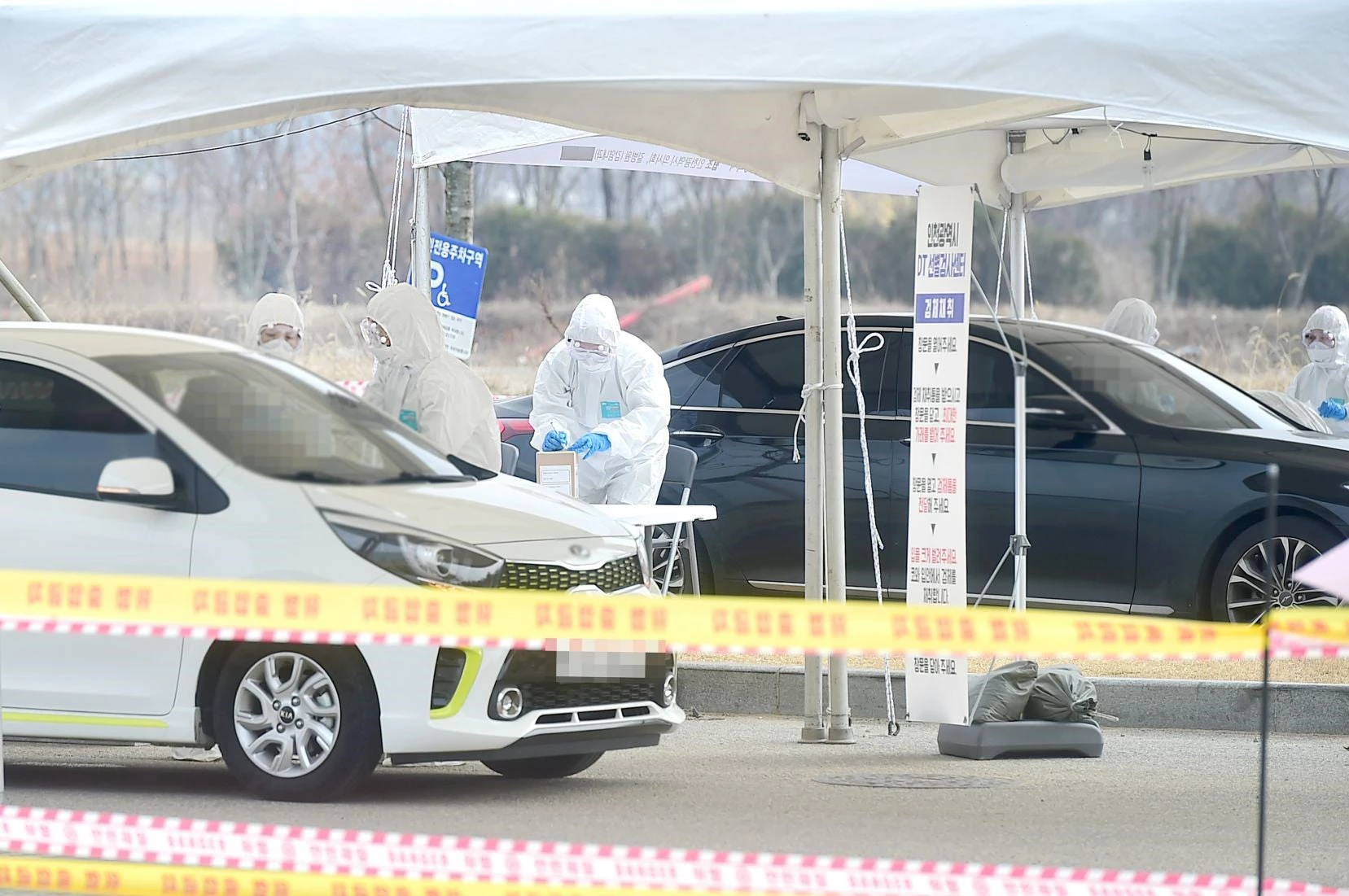The Republic of Korea was one of the first countries to tackle the COVID-19 crisis. Facing a rapid, exponential increase in infections after the first positive case was identified on January 20, the country took decisive action to contain the virus. Although the total number of cases is high, daily increases have been declining steadily from a peak of just above 900 in late February to around 100 by the second week of March (Figure 1). Recovered cases now far outnumber new cases, and deaths have been kept just above 100 as of this writing.
Figure 1. Coronavirus cases in Korea
While health authorities remain on high alert, many are optimistic that the country has turned the corner. Korea offers a model for other countries battling COVID-19 , as noted recently by the World Health Organization.
Applying lessons learned from the MERS outbreak in 2015, Korea has been strengthening its infectious disease surveillance and response capacity. Recent legislation established a comprehensive framework to address infectious disease and gives the government specific levers to allocate resources, collect data, and mobilize public and private stakeholders to combat infectious disease. Clear responsibilities have been assigned throughout the government on prevention and containment, on-the-ground response, and treatment and quarantine.
The Korea Centers for Disease Control and Prevention (KCDC) has also been upgraded through increased staffing and training, particularly in epidemiology. Specialized divisions have been established for risk assessment, emergency operations, crisis communication, and partner coordination. Hospitals have also strengthened their capacity for infectious disease prevention and control; this has lowered infection risks for health care workers during the current crisis.
COVID-19 activated the country’s highest infectious disease alert level, at which the Central Disaster and Safety Countermeasures Headquarters, headed by the Prime Minister, plans and directs responses. The KCDC centrally coordinates with provincial and municipal governments and specialized hospitals. Subnational Centers for Epidemic Countermeasures have been established in these local governments to coordinate with central authorities.
Multi-level approach
Transparency and communication have helped allay fear and prevent panic. The government rolled out a massive public information campaign on personal hygiene and social distancing. It has conducted twice-daily press briefings, updated its online information continuously, and sent out targeted text messages. Combined with a massive rollout of testing and information on the results, fear and misinformation have been minimized. Experience with the MERS may also have made Koreans better prepared to follow public health communication on COVID-19.
The government restricted large gatherings, closed schools and daycare centers, and asked employers to offer flexible work arrangements. Daegu city and three counties in North Gyeongsang were designated as special care zones and later declared disaster areas so that they could benefit from additional resources and health professionals. But the government largely avoided restricting or controlling the movement of people, and international borders have remained relatively open to travelers from affected countries. The only outright bans have been for travelers from China’s Hubei province.
The KCDC used emergency procedures to fast-track development of testing. Korea now can conduct up to 18,000 tests a day and is exporting test kits to other countries. The government is helping make testing affordable and has used innovative drive-through testing facilities (Figure 2) to encourage the public to get tested. More than 316,000 people have been tested (as of March 20), with Korea having one of the highest testing rates per capita (Figure 3). This has allowed rapid case identification and isolation without requiring far-reaching mobility restrictions or business closures. The high rate of testing may also explain the country’s low fatality rate, as even mild cases have been systematically tested and isolated.
Figure 2. Drive-through testing facilities
Korea has used Big Data, such as GPS tracking data from phones and cars, credit card transactions, travel histories, CCTV footage, and artificial intelligence to identify high-priority cases and track the routes of infected individuals. Smartphone apps have been deployed for inbound international travelers who are undergoing the 14-day self-monitoring period and for suspected coronavirus cases who are in mandatory self-isolation. By facilitating self-monitoring and reporting data to the government, this prevented a ban on entry by international travelers. Hospitals have introduced remote diagnosis for patients with mild symptoms, helping free up medical professionals to focus on those with more serious symptoms.
Figure 3. Total COVID-19 testing per million people
Partnering on public health crisis preparedness
Since 2018, the KCDC has been working with the Korea International Cooperation Agency (KOICA), the country’s bilateral development agency, on infectious disease-related projects, as part of the country’s contribution to the global public health agenda.
Korea has also encouraged public-private partnerships to leverage technology for better health outcomes. For example, KT, a major Korean ICT company, has developed its Global Epidemic Prevention Platform (GEPP), an infectious disease prevention platform that it is piloting in Ghana and Kenya, with plans for expansion in East Asia. A smartphone app alerts mobile phone users of nearby outbreaks and lets them communicate their health conditions to authorities.
KT’s GEPP and other innovative technologies were highlighted at Korea Innovation Week at World Bank Group headquarters in February 2020. The country’s public and private partners seek to collaborate further on global health, including with the World Bank Group as it rolls out its $14 billion facility to help developing countries deal with the COVID-19 crisis and build capacity for response to future crises.
READ MORE






Join the Conversation